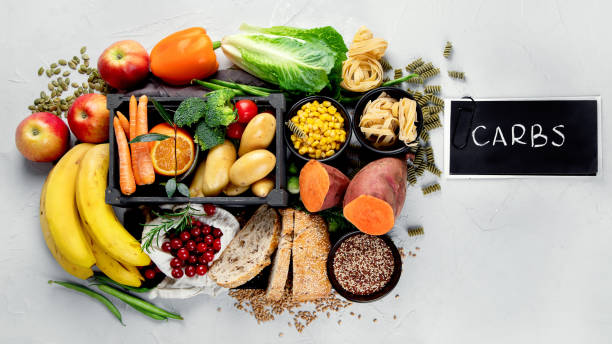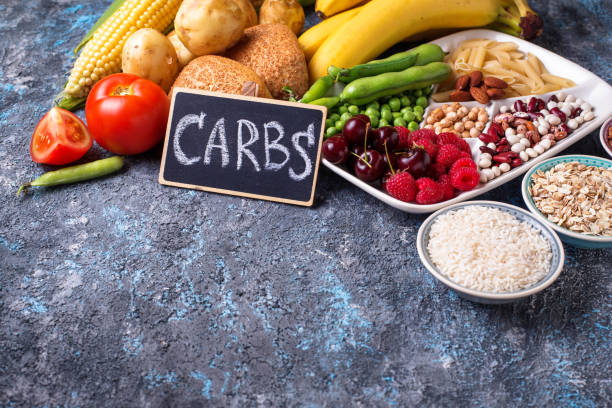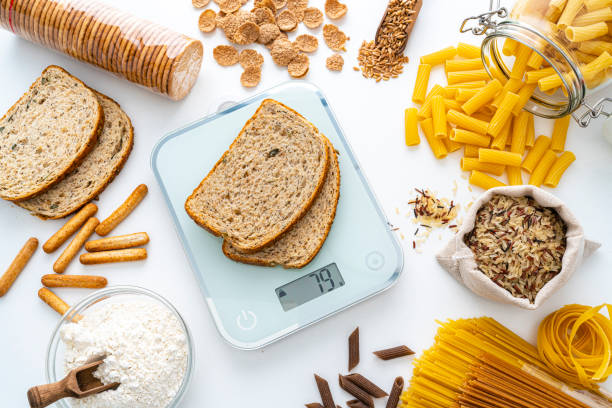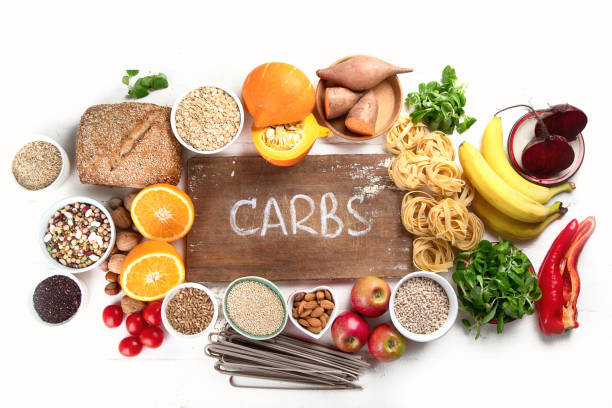What Are Carbohydrates?
Carbohydrates, or “carbs,” are one of the three main nutrients your body needs, along with protein and fat. They are found in foods like bread, rice, fruits, vegetables, and dairy products. When you eat carbohydrates, your body breaks them down into glucose (sugar), which your cells use for energy. This process helps fuel your brain, muscles, and other organs.
But if you have diabetes, eating too many carbs at once can cause your blood sugar levels to spike. Over time, high blood sugar can lead to serious health problems like nerve damage, heart disease, and kidney issues. That’s why people with diabetes need to watch their carb intake and choose healthy sources like whole grains, beans, and non-starchy vegetables.
There are three main types of carbohydrates:
- Sugars – Found in candy, soda, fruit, and milk, sugars are a type of carbohydrate that your body breaks down quickly for energy.
- Starches – Found in bread, pasta, rice, and potatoes, starches are complex carbohydrates that your body breaks down into glucose for energy.
- Fiber – Found in fruits, veggies, beans, and whole grains, fiber is a type of carbohydrate that your body cannot fully digest.
Key Point: Not all carbs are bad. It’s about the type and how much you eat.
How Carbs Affect Blood Sugar
When you eat carbohydrates, your body breaks them down into glucose. This causes your blood sugar to rise. In response, your body releases insulin—a hormone made by your pancreas. Insulin helps move glucose from your blood into your cells, where it’s used for energy. But if you have diabetes, your body either doesn’t make enough insulin or can’t use it properly.
This means glucose stays in your blood instead of going into your cells. As a result, your blood sugar can stay too high, which can lead to serious health problems over time if not managed.
Why This Matters
- Too many carbs = high blood sugar
- Too few carbs = low energy and nutrient loss
- Balanced carbs = better control and steady energy
According to the American Diabetes Association, counting carbs helps you keep your blood sugar levels within a healthy range. By tracking how many grams of carbohydrates you eat at each meal or snack, you can better match your food intake with your body’s insulin response.
This helps prevent spikes or drops in blood sugar. Carb counting also makes it easier to plan balanced meals and avoid overeating. For people with diabetes, learning how to count carbs can be an important tool for daily blood sugar control and long-term health.

How Many Carbs Should You Eat?
There’s no one-size-fits-all answer. Your carb needs depend on your:
- Age
- Weight
- Activity level
- Type of diabetes
- Medications or insulin use
General Guidelines
Most people with diabetes do well eating about 45–60 grams of carbs per meal. But this may change based on your health goals. Your age, weight, activity level, and whether you take insulin or other medications can all affect how many carbohydrates you need. Some people may need more carbs for energy, while others may need less to manage their blood sugar.
It’s important to work with a doctor or dietitian to find the right amount for you. Keeping a food log or using a carb-tracking app can help you stay on track and make adjustments as needed.
Tip: Work with a dietitian or diabetes educator to find your ideal carb limit.
Best Carbs for Diabetes
Not all carbs are created equal. Some carbohydrates break down quickly and cause blood sugar to rise fast, while others digest slowly and have a gentler effect. Focus on high-fiber, nutrient-rich carbs that digest slowly and keep blood sugar steady. These include foods like whole grains, fruits, vegetables, beans, and lentils.
They not only provide lasting energy but also contain vitamins, minerals, and antioxidants that support overall health. Avoid or limit refined carbs like white bread, sugary snacks, and sweetened drinks, which can lead to blood sugar spikes and crashes.
Smart Carb Choices
- Whole grains (oats, brown rice, quinoa)
- Vegetables (broccoli, spinach, carrots)
- Fruits (berries, apples, oranges)
- Legumes (beans, lentils, chickpeas)
- Dairy (low-fat milk, Greek yogurt)
These carbs provide:
- Fiber
- Vitamins and minerals
- Longer-lasting energy
Carbs to Limit
Try to avoid or limit:
- Sugary drinks (soda, fruit juice)
- White bread and pasta
- Pastries, cakes, and cookies
- Candy and other sweets
- Processed snack foods
These raise blood sugar fast and provide little nutrition.
Understanding the Glycemic Index (GI)
The Glycemic Index (GI) measures how quickly carbohydrates raise blood sugar. Foods are ranked from 0 to 100. The higher the number, the faster the food raises your blood sugar. High-GI foods, like white bread or sugary snacks, cause quick spikes in blood sugar. Low-GI foods, like oats, lentils, and most fruits, raise blood sugar more slowly.
Choosing low- to medium-GI foods can help people with diabetes keep their blood sugar levels steady. The GI can be a helpful tool when planning meals, especially when combined with carb counting and portion control.
- Low GI (55 or less): Slowly raises blood sugar
- Medium GI (56–69): Moderate rise
- High GI (70 or more): Quickly raises blood sugar
Choose Low-GI Foods
Low-GI foods help manage blood sugar better. Good options include:
- Sweet potatoes
- Barley
- Lentils
- Apples and pears
- Non-starchy veggies
Check out this Harvard GI chart for a full list.

How to Count Carbs
Counting carbs means keeping track of how many grams of carbohydrates you eat. This helps balance meals and avoid blood sugar spikes. When you know how many carbohydrates are in your food, you can plan better portions and choose foods that support stable blood sugar. Carb counting is especially helpful for people who take insulin, as it allows them to match their insulin dose to the amount of carbs they eat.
It can also help with weight management and make it easier to stick to a healthy eating plan. You can count carbohydrates by reading food labels, using a carb guide, or tracking your meals with an app.
Step-by-Step Carb Counting
- Read nutrition labels
- Use carb-counting apps
- Measure your food portions
- Use a food scale or measuring cups
- Plan meals ahead
Example Meal Plan
| Meal | Food | Carb Count |
|---|---|---|
| Breakfast | Oatmeal with berries | 40g |
| Snack | Greek yogurt with nuts | 15g |
| Lunch | Chicken salad + whole wheat wrap | 45g |
| Dinner | Grilled fish, quinoa, veggies | 50g |
| Total | ~150g |
Note: Your needs may vary.
Low-Carb Diets and Diabetes
Some people with diabetes try low-carb diets to lower blood sugar and lose weight. This can work, but it’s not right for everyone. Cutting back on carbs may help reduce blood sugar spikes and improve insulin sensitivity. It can also support weight loss by lowering calorie intake and helping you feel full longer.
However, going too low in carbs may lead to low energy, nutrient gaps, or difficulty sticking with the plan. It’s important to find a balance that fits your lifestyle and health needs. Always talk to your doctor or a registered dietitian before starting a low-carb diet to make sure it’s safe and effective for you.
Pros
- Better blood sugar control
- May help with weight loss
- May reduce need for medication
Cons
- Hard to stick with long-term
- May lack fiber or certain nutrients
- Not ideal for everyone (especially those on insulin)
Talk to your doctor before starting any low-carb plan.
Carb Tips for Daily Life
Here are some simple tips to help you manage carbs every day:
- Plan your meals – Know what you’ll eat in advance.
- Watch your portions – Use smaller plates to avoid overeating.
- Include protein and fat – These slow down how fast carbs digest.
- Snack smart – Choose nuts, hard-boiled eggs, or low-carb veggies.
- Stay active – Exercise helps lower blood sugar after eating.

Common Myths About Carbs and Diabetes
Myth #1: People with diabetes should avoid carbs completely
Truth: You need carbs for energy. The key is balance and smart choices.
Myth #2: Fruit is bad for blood sugar
Truth: Whole fruit is rich in fiber and nutrients. Just watch your portions.
Myth #3: All carbs raise blood sugar the same way
Truth: High-fiber and low-GI carbs raise blood sugar more slowly.
When to See a Dietitian
A registered dietitian (RD) can:
- Create a custom meal plan
- Help you count carbs the right way
- Offer tips that fit your lifestyle
Find a certified diabetes care and education specialist at EatRight.org.
Final Thoughts: You Can Enjoy Carbs with Diabetes
Carbs aren’t the enemy. Your body needs them for energy, especially your brain and muscles. The key is choosing the right ones and knowing how much to eat. Focus on carbs that are high in fiber, like fruits, vegetables, whole grains, and legumes. These carbs digest more slowly, helping you avoid blood sugar spikes.
With smart planning, you can enjoy meals, feel full, and keep your blood sugar in check. Pay attention to portion sizes, read food labels, and spread your carbs throughout the day to stay balanced. Eating the right carbs can be part of a healthy and satisfying diet for people with diabetes.
Remember:
- Balance is better than restriction
- Small changes make a big difference
- You’re in control of your health
Call to Action
Ready to take charge of your blood sugar and feel better every day?
👉 Start by tracking your carbs today.

